Management Accounting Report: Cost Analysis and Planning
VerifiedAdded on 2020/10/22
|12
|3593
|125
Report
AI Summary
This report delves into the core principles of management accounting, emphasizing its significance in organizational decision-making and financial planning. It begins by differentiating management accounting from financial accounting, highlighting their distinct objectives, scope, and application. The report then explores various cost evaluation methods, including marginal costing and absorption costing, providing detailed calculations and comparisons to illustrate their impact on profit analysis. Furthermore, it examines different types of budgets used in budgetary control, along with their advantages, and elucidates the budget preparation process. The report also underscores the importance of budgeting as a vital tool for planning and control, offering insights into the implications of management accounting systems in addressing financial problems and conflicts. Through comprehensive analysis and practical examples, the report aims to provide a thorough understanding of management accounting concepts and their practical applications in business environments.
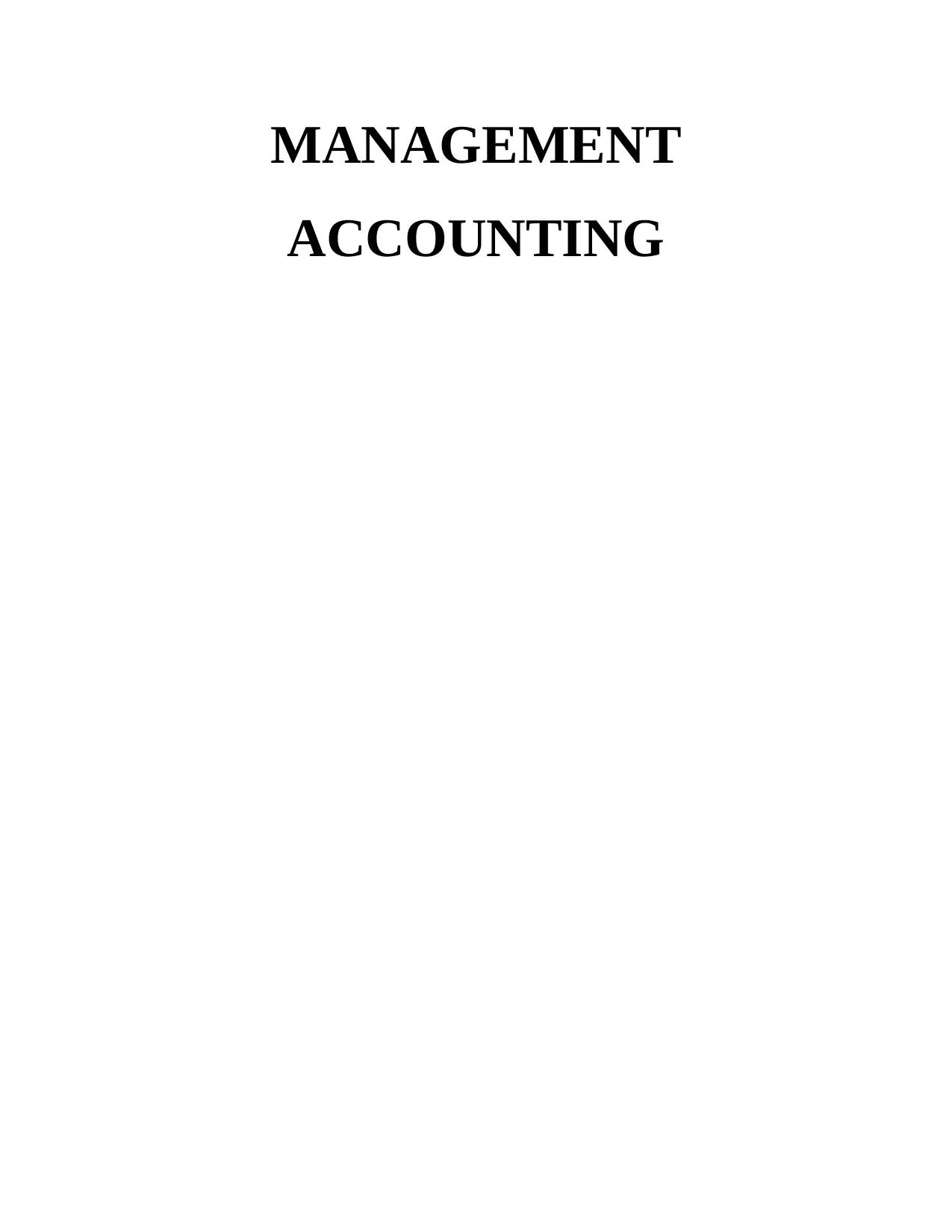
MANAGEMENT
ACCOUNTING
ACCOUNTING
Paraphrase This Document
Need a fresh take? Get an instant paraphrase of this document with our AI Paraphraser
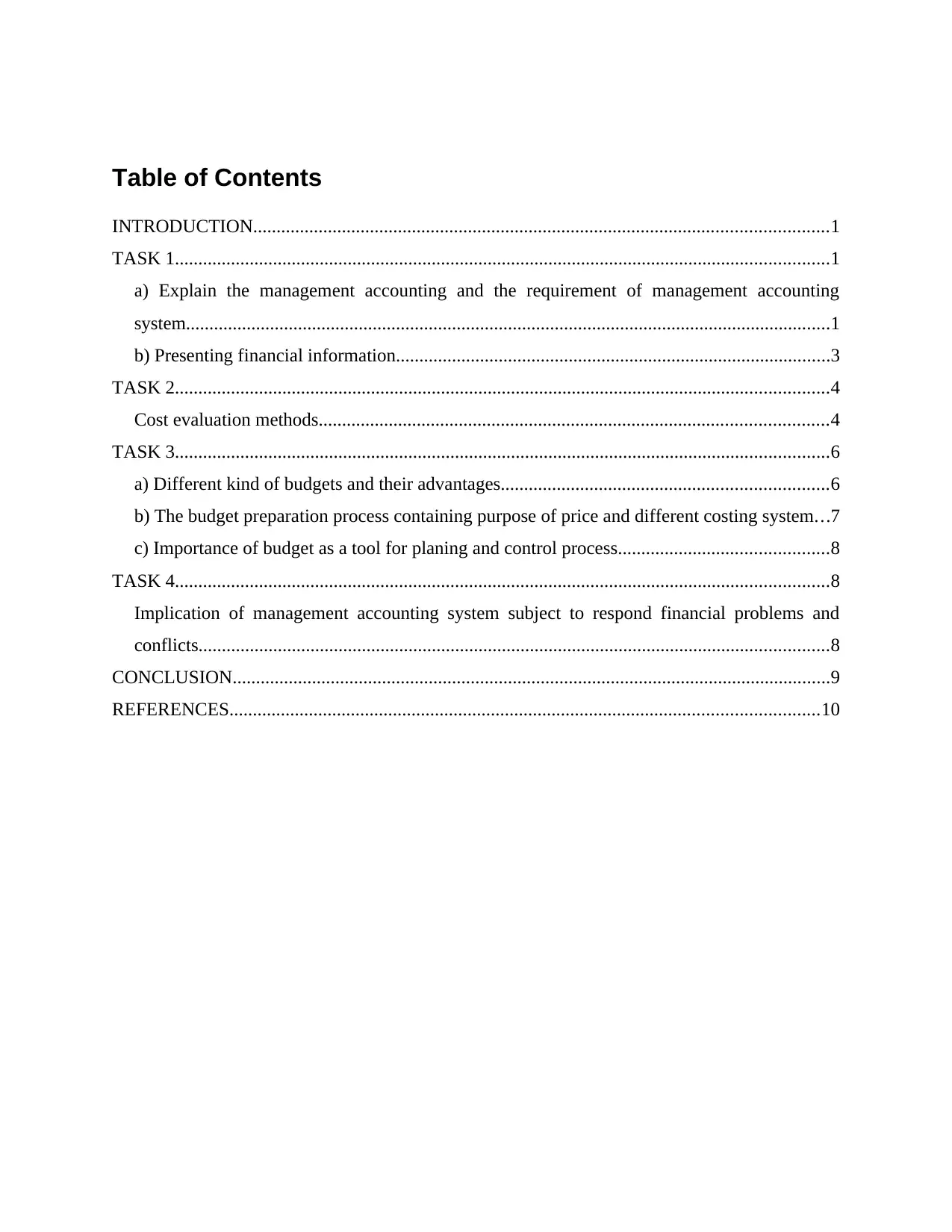
Table of Contents
INTRODUCTION...........................................................................................................................1
TASK 1............................................................................................................................................1
a) Explain the management accounting and the requirement of management accounting
system..........................................................................................................................................1
b) Presenting financial information.............................................................................................3
TASK 2............................................................................................................................................4
Cost evaluation methods.............................................................................................................4
TASK 3............................................................................................................................................6
a) Different kind of budgets and their advantages......................................................................6
b) The budget preparation process containing purpose of price and different costing system...7
c) Importance of budget as a tool for planing and control process.............................................8
TASK 4............................................................................................................................................8
Implication of management accounting system subject to respond financial problems and
conflicts.......................................................................................................................................8
CONCLUSION................................................................................................................................9
REFERENCES..............................................................................................................................10
INTRODUCTION...........................................................................................................................1
TASK 1............................................................................................................................................1
a) Explain the management accounting and the requirement of management accounting
system..........................................................................................................................................1
b) Presenting financial information.............................................................................................3
TASK 2............................................................................................................................................4
Cost evaluation methods.............................................................................................................4
TASK 3............................................................................................................................................6
a) Different kind of budgets and their advantages......................................................................6
b) The budget preparation process containing purpose of price and different costing system...7
c) Importance of budget as a tool for planing and control process.............................................8
TASK 4............................................................................................................................................8
Implication of management accounting system subject to respond financial problems and
conflicts.......................................................................................................................................8
CONCLUSION................................................................................................................................9
REFERENCES..............................................................................................................................10
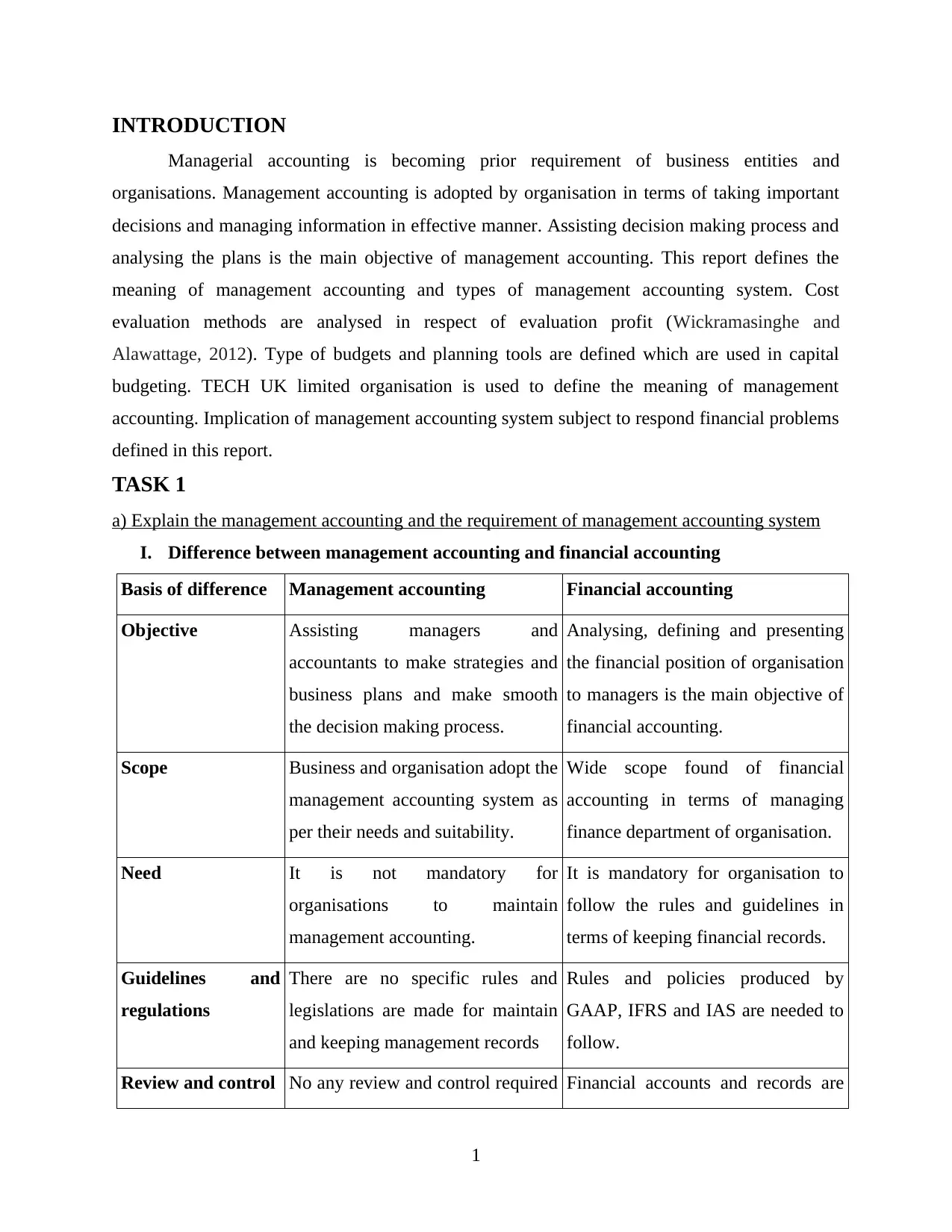
INTRODUCTION
Managerial accounting is becoming prior requirement of business entities and
organisations. Management accounting is adopted by organisation in terms of taking important
decisions and managing information in effective manner. Assisting decision making process and
analysing the plans is the main objective of management accounting. This report defines the
meaning of management accounting and types of management accounting system. Cost
evaluation methods are analysed in respect of evaluation profit (Wickramasinghe and
Alawattage, 2012). Type of budgets and planning tools are defined which are used in capital
budgeting. TECH UK limited organisation is used to define the meaning of management
accounting. Implication of management accounting system subject to respond financial problems
defined in this report.
TASK 1
a) Explain the management accounting and the requirement of management accounting system
I. Difference between management accounting and financial accounting
Basis of difference Management accounting Financial accounting
Objective Assisting managers and
accountants to make strategies and
business plans and make smooth
the decision making process.
Analysing, defining and presenting
the financial position of organisation
to managers is the main objective of
financial accounting.
Scope Business and organisation adopt the
management accounting system as
per their needs and suitability.
Wide scope found of financial
accounting in terms of managing
finance department of organisation.
Need It is not mandatory for
organisations to maintain
management accounting.
It is mandatory for organisation to
follow the rules and guidelines in
terms of keeping financial records.
Guidelines and
regulations
There are no specific rules and
legislations are made for maintain
and keeping management records
Rules and policies produced by
GAAP, IFRS and IAS are needed to
follow.
Review and control No any review and control required Financial accounts and records are
1
Managerial accounting is becoming prior requirement of business entities and
organisations. Management accounting is adopted by organisation in terms of taking important
decisions and managing information in effective manner. Assisting decision making process and
analysing the plans is the main objective of management accounting. This report defines the
meaning of management accounting and types of management accounting system. Cost
evaluation methods are analysed in respect of evaluation profit (Wickramasinghe and
Alawattage, 2012). Type of budgets and planning tools are defined which are used in capital
budgeting. TECH UK limited organisation is used to define the meaning of management
accounting. Implication of management accounting system subject to respond financial problems
defined in this report.
TASK 1
a) Explain the management accounting and the requirement of management accounting system
I. Difference between management accounting and financial accounting
Basis of difference Management accounting Financial accounting
Objective Assisting managers and
accountants to make strategies and
business plans and make smooth
the decision making process.
Analysing, defining and presenting
the financial position of organisation
to managers is the main objective of
financial accounting.
Scope Business and organisation adopt the
management accounting system as
per their needs and suitability.
Wide scope found of financial
accounting in terms of managing
finance department of organisation.
Need It is not mandatory for
organisations to maintain
management accounting.
It is mandatory for organisation to
follow the rules and guidelines in
terms of keeping financial records.
Guidelines and
regulations
There are no specific rules and
legislations are made for maintain
and keeping management records
Rules and policies produced by
GAAP, IFRS and IAS are needed to
follow.
Review and control No any review and control required Financial accounts and records are
1
⊘ This is a preview!⊘
Do you want full access?
Subscribe today to unlock all pages.

Trusted by 1+ million students worldwide
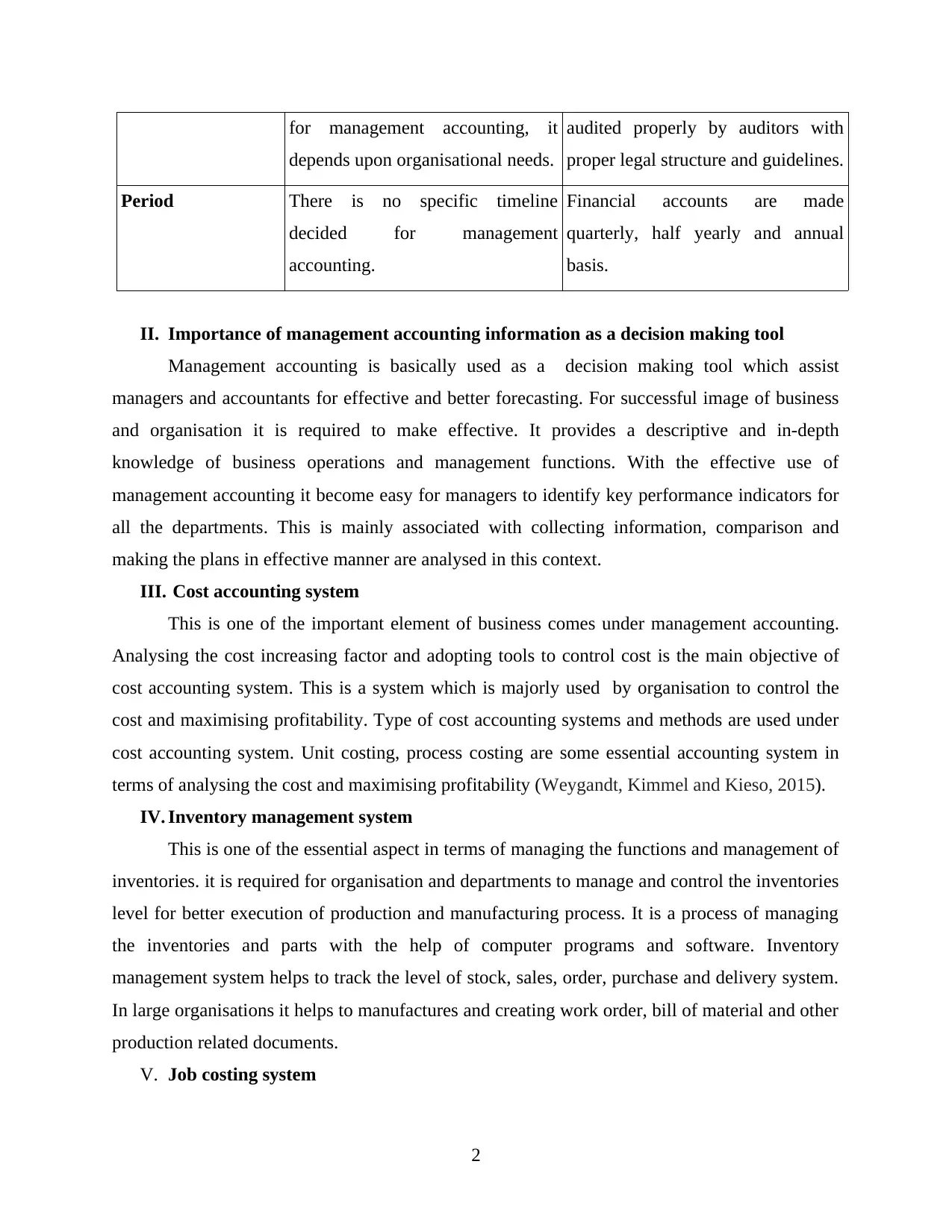
for management accounting, it
depends upon organisational needs.
audited properly by auditors with
proper legal structure and guidelines.
Period There is no specific timeline
decided for management
accounting.
Financial accounts are made
quarterly, half yearly and annual
basis.
II. Importance of management accounting information as a decision making tool
Management accounting is basically used as a decision making tool which assist
managers and accountants for effective and better forecasting. For successful image of business
and organisation it is required to make effective. It provides a descriptive and in-depth
knowledge of business operations and management functions. With the effective use of
management accounting it become easy for managers to identify key performance indicators for
all the departments. This is mainly associated with collecting information, comparison and
making the plans in effective manner are analysed in this context.
III. Cost accounting system
This is one of the important element of business comes under management accounting.
Analysing the cost increasing factor and adopting tools to control cost is the main objective of
cost accounting system. This is a system which is majorly used by organisation to control the
cost and maximising profitability. Type of cost accounting systems and methods are used under
cost accounting system. Unit costing, process costing are some essential accounting system in
terms of analysing the cost and maximising profitability (Weygandt, Kimmel and Kieso, 2015).
IV. Inventory management system
This is one of the essential aspect in terms of managing the functions and management of
inventories. it is required for organisation and departments to manage and control the inventories
level for better execution of production and manufacturing process. It is a process of managing
the inventories and parts with the help of computer programs and software. Inventory
management system helps to track the level of stock, sales, order, purchase and delivery system.
In large organisations it helps to manufactures and creating work order, bill of material and other
production related documents.
V. Job costing system
2
depends upon organisational needs.
audited properly by auditors with
proper legal structure and guidelines.
Period There is no specific timeline
decided for management
accounting.
Financial accounts are made
quarterly, half yearly and annual
basis.
II. Importance of management accounting information as a decision making tool
Management accounting is basically used as a decision making tool which assist
managers and accountants for effective and better forecasting. For successful image of business
and organisation it is required to make effective. It provides a descriptive and in-depth
knowledge of business operations and management functions. With the effective use of
management accounting it become easy for managers to identify key performance indicators for
all the departments. This is mainly associated with collecting information, comparison and
making the plans in effective manner are analysed in this context.
III. Cost accounting system
This is one of the important element of business comes under management accounting.
Analysing the cost increasing factor and adopting tools to control cost is the main objective of
cost accounting system. This is a system which is majorly used by organisation to control the
cost and maximising profitability. Type of cost accounting systems and methods are used under
cost accounting system. Unit costing, process costing are some essential accounting system in
terms of analysing the cost and maximising profitability (Weygandt, Kimmel and Kieso, 2015).
IV. Inventory management system
This is one of the essential aspect in terms of managing the functions and management of
inventories. it is required for organisation and departments to manage and control the inventories
level for better execution of production and manufacturing process. It is a process of managing
the inventories and parts with the help of computer programs and software. Inventory
management system helps to track the level of stock, sales, order, purchase and delivery system.
In large organisations it helps to manufactures and creating work order, bill of material and other
production related documents.
V. Job costing system
2
Paraphrase This Document
Need a fresh take? Get an instant paraphrase of this document with our AI Paraphraser
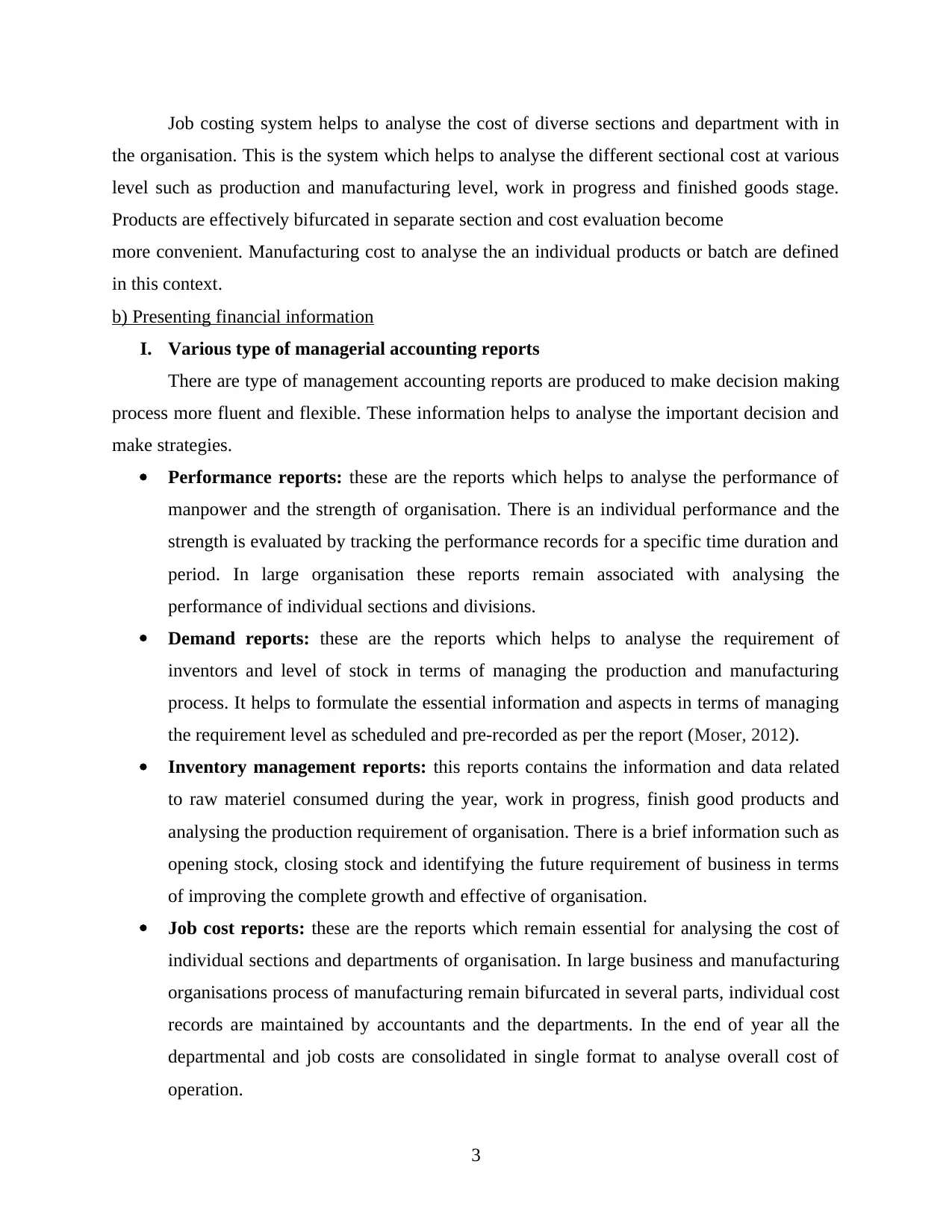
Job costing system helps to analyse the cost of diverse sections and department with in
the organisation. This is the system which helps to analyse the different sectional cost at various
level such as production and manufacturing level, work in progress and finished goods stage.
Products are effectively bifurcated in separate section and cost evaluation become
more convenient. Manufacturing cost to analyse the an individual products or batch are defined
in this context.
b) Presenting financial information
I. Various type of managerial accounting reports
There are type of management accounting reports are produced to make decision making
process more fluent and flexible. These information helps to analyse the important decision and
make strategies.
Performance reports: these are the reports which helps to analyse the performance of
manpower and the strength of organisation. There is an individual performance and the
strength is evaluated by tracking the performance records for a specific time duration and
period. In large organisation these reports remain associated with analysing the
performance of individual sections and divisions.
Demand reports: these are the reports which helps to analyse the requirement of
inventors and level of stock in terms of managing the production and manufacturing
process. It helps to formulate the essential information and aspects in terms of managing
the requirement level as scheduled and pre-recorded as per the report (Moser, 2012).
Inventory management reports: this reports contains the information and data related
to raw materiel consumed during the year, work in progress, finish good products and
analysing the production requirement of organisation. There is a brief information such as
opening stock, closing stock and identifying the future requirement of business in terms
of improving the complete growth and effective of organisation.
Job cost reports: these are the reports which remain essential for analysing the cost of
individual sections and departments of organisation. In large business and manufacturing
organisations process of manufacturing remain bifurcated in several parts, individual cost
records are maintained by accountants and the departments. In the end of year all the
departmental and job costs are consolidated in single format to analyse overall cost of
operation.
3
the organisation. This is the system which helps to analyse the different sectional cost at various
level such as production and manufacturing level, work in progress and finished goods stage.
Products are effectively bifurcated in separate section and cost evaluation become
more convenient. Manufacturing cost to analyse the an individual products or batch are defined
in this context.
b) Presenting financial information
I. Various type of managerial accounting reports
There are type of management accounting reports are produced to make decision making
process more fluent and flexible. These information helps to analyse the important decision and
make strategies.
Performance reports: these are the reports which helps to analyse the performance of
manpower and the strength of organisation. There is an individual performance and the
strength is evaluated by tracking the performance records for a specific time duration and
period. In large organisation these reports remain associated with analysing the
performance of individual sections and divisions.
Demand reports: these are the reports which helps to analyse the requirement of
inventors and level of stock in terms of managing the production and manufacturing
process. It helps to formulate the essential information and aspects in terms of managing
the requirement level as scheduled and pre-recorded as per the report (Moser, 2012).
Inventory management reports: this reports contains the information and data related
to raw materiel consumed during the year, work in progress, finish good products and
analysing the production requirement of organisation. There is a brief information such as
opening stock, closing stock and identifying the future requirement of business in terms
of improving the complete growth and effective of organisation.
Job cost reports: these are the reports which remain essential for analysing the cost of
individual sections and departments of organisation. In large business and manufacturing
organisations process of manufacturing remain bifurcated in several parts, individual cost
records are maintained by accountants and the departments. In the end of year all the
departmental and job costs are consolidated in single format to analyse overall cost of
operation.
3
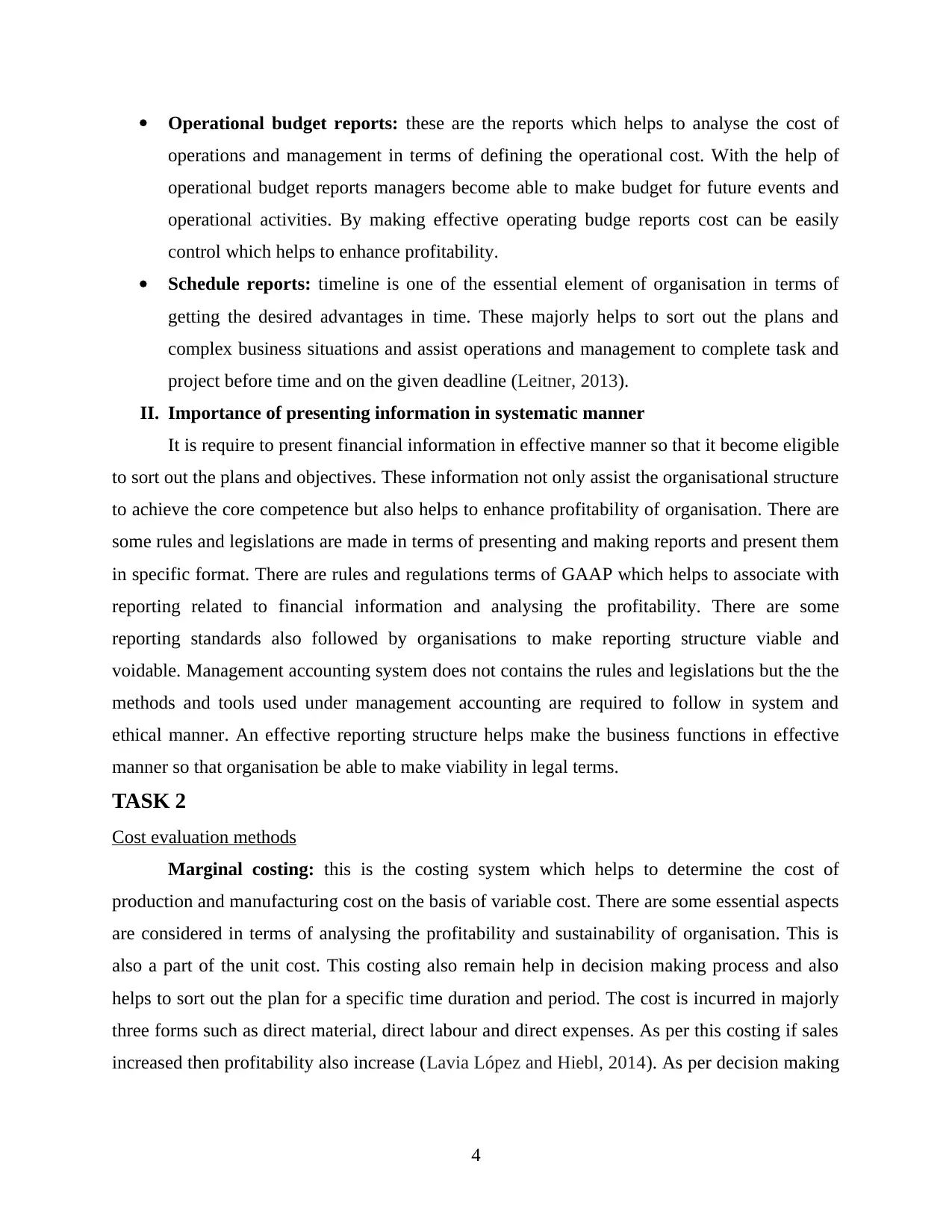
Operational budget reports: these are the reports which helps to analyse the cost of
operations and management in terms of defining the operational cost. With the help of
operational budget reports managers become able to make budget for future events and
operational activities. By making effective operating budge reports cost can be easily
control which helps to enhance profitability.
Schedule reports: timeline is one of the essential element of organisation in terms of
getting the desired advantages in time. These majorly helps to sort out the plans and
complex business situations and assist operations and management to complete task and
project before time and on the given deadline (Leitner, 2013).
II. Importance of presenting information in systematic manner
It is require to present financial information in effective manner so that it become eligible
to sort out the plans and objectives. These information not only assist the organisational structure
to achieve the core competence but also helps to enhance profitability of organisation. There are
some rules and legislations are made in terms of presenting and making reports and present them
in specific format. There are rules and regulations terms of GAAP which helps to associate with
reporting related to financial information and analysing the profitability. There are some
reporting standards also followed by organisations to make reporting structure viable and
voidable. Management accounting system does not contains the rules and legislations but the the
methods and tools used under management accounting are required to follow in system and
ethical manner. An effective reporting structure helps make the business functions in effective
manner so that organisation be able to make viability in legal terms.
TASK 2
Cost evaluation methods
Marginal costing: this is the costing system which helps to determine the cost of
production and manufacturing cost on the basis of variable cost. There are some essential aspects
are considered in terms of analysing the profitability and sustainability of organisation. This is
also a part of the unit cost. This costing also remain help in decision making process and also
helps to sort out the plan for a specific time duration and period. The cost is incurred in majorly
three forms such as direct material, direct labour and direct expenses. As per this costing if sales
increased then profitability also increase (Lavia López and Hiebl, 2014). As per decision making
4
operations and management in terms of defining the operational cost. With the help of
operational budget reports managers become able to make budget for future events and
operational activities. By making effective operating budge reports cost can be easily
control which helps to enhance profitability.
Schedule reports: timeline is one of the essential element of organisation in terms of
getting the desired advantages in time. These majorly helps to sort out the plans and
complex business situations and assist operations and management to complete task and
project before time and on the given deadline (Leitner, 2013).
II. Importance of presenting information in systematic manner
It is require to present financial information in effective manner so that it become eligible
to sort out the plans and objectives. These information not only assist the organisational structure
to achieve the core competence but also helps to enhance profitability of organisation. There are
some rules and legislations are made in terms of presenting and making reports and present them
in specific format. There are rules and regulations terms of GAAP which helps to associate with
reporting related to financial information and analysing the profitability. There are some
reporting standards also followed by organisations to make reporting structure viable and
voidable. Management accounting system does not contains the rules and legislations but the the
methods and tools used under management accounting are required to follow in system and
ethical manner. An effective reporting structure helps make the business functions in effective
manner so that organisation be able to make viability in legal terms.
TASK 2
Cost evaluation methods
Marginal costing: this is the costing system which helps to determine the cost of
production and manufacturing cost on the basis of variable cost. There are some essential aspects
are considered in terms of analysing the profitability and sustainability of organisation. This is
also a part of the unit cost. This costing also remain help in decision making process and also
helps to sort out the plan for a specific time duration and period. The cost is incurred in majorly
three forms such as direct material, direct labour and direct expenses. As per this costing if sales
increased then profitability also increase (Lavia López and Hiebl, 2014). As per decision making
4
⊘ This is a preview!⊘
Do you want full access?
Subscribe today to unlock all pages.

Trusted by 1+ million students worldwide
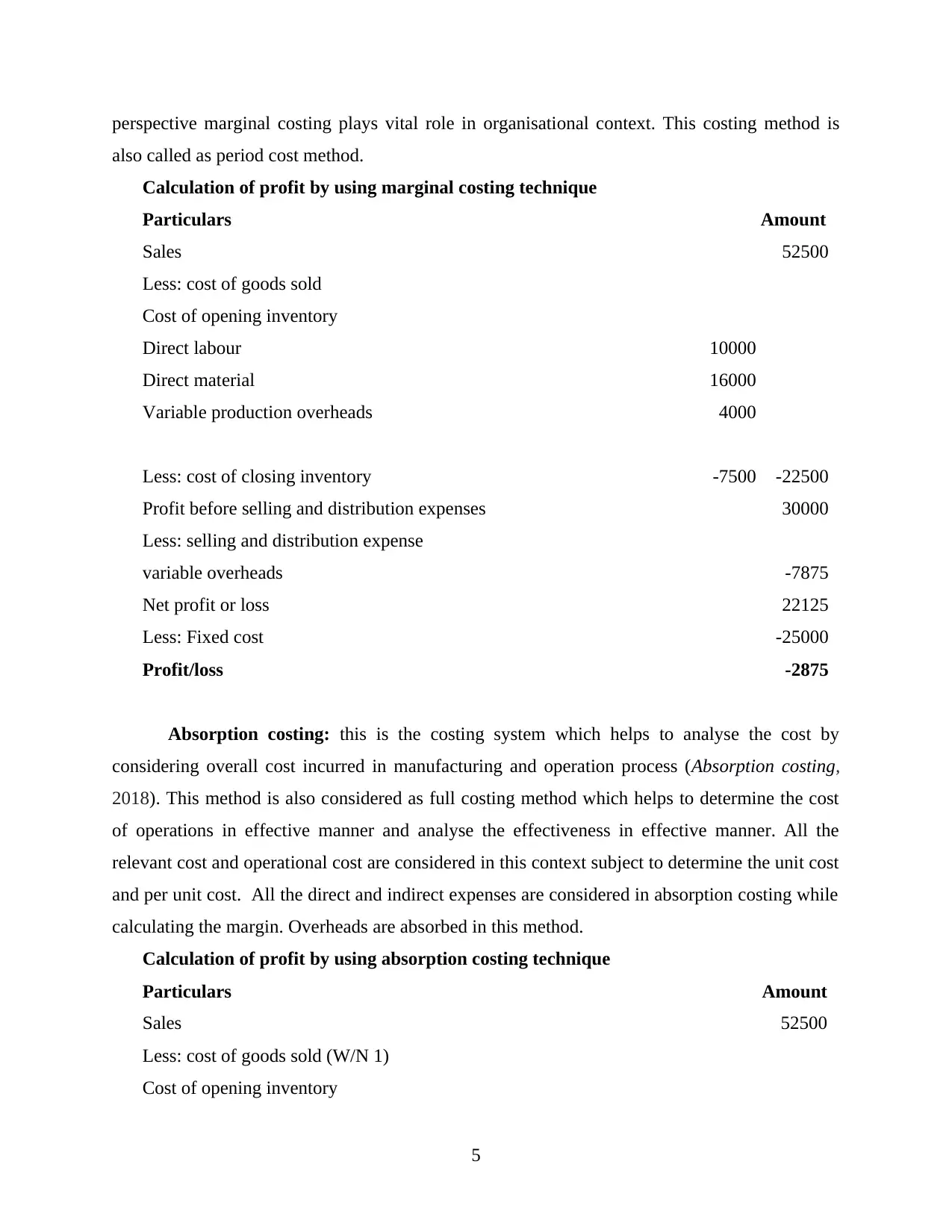
perspective marginal costing plays vital role in organisational context. This costing method is
also called as period cost method.
Calculation of profit by using marginal costing technique
Particulars Amount
Sales 52500
Less: cost of goods sold
Cost of opening inventory
Direct labour 10000
Direct material 16000
Variable production overheads 4000
Less: cost of closing inventory -7500 -22500
Profit before selling and distribution expenses 30000
Less: selling and distribution expense
variable overheads -7875
Net profit or loss 22125
Less: Fixed cost -25000
Profit/loss -2875
Absorption costing: this is the costing system which helps to analyse the cost by
considering overall cost incurred in manufacturing and operation process (Absorption costing,
2018). This method is also considered as full costing method which helps to determine the cost
of operations in effective manner and analyse the effectiveness in effective manner. All the
relevant cost and operational cost are considered in this context subject to determine the unit cost
and per unit cost. All the direct and indirect expenses are considered in absorption costing while
calculating the margin. Overheads are absorbed in this method.
Calculation of profit by using absorption costing technique
Particulars Amount
Sales 52500
Less: cost of goods sold (W/N 1)
Cost of opening inventory
5
also called as period cost method.
Calculation of profit by using marginal costing technique
Particulars Amount
Sales 52500
Less: cost of goods sold
Cost of opening inventory
Direct labour 10000
Direct material 16000
Variable production overheads 4000
Less: cost of closing inventory -7500 -22500
Profit before selling and distribution expenses 30000
Less: selling and distribution expense
variable overheads -7875
Net profit or loss 22125
Less: Fixed cost -25000
Profit/loss -2875
Absorption costing: this is the costing system which helps to analyse the cost by
considering overall cost incurred in manufacturing and operation process (Absorption costing,
2018). This method is also considered as full costing method which helps to determine the cost
of operations in effective manner and analyse the effectiveness in effective manner. All the
relevant cost and operational cost are considered in this context subject to determine the unit cost
and per unit cost. All the direct and indirect expenses are considered in absorption costing while
calculating the margin. Overheads are absorbed in this method.
Calculation of profit by using absorption costing technique
Particulars Amount
Sales 52500
Less: cost of goods sold (W/N 1)
Cost of opening inventory
5
Paraphrase This Document
Need a fresh take? Get an instant paraphrase of this document with our AI Paraphraser
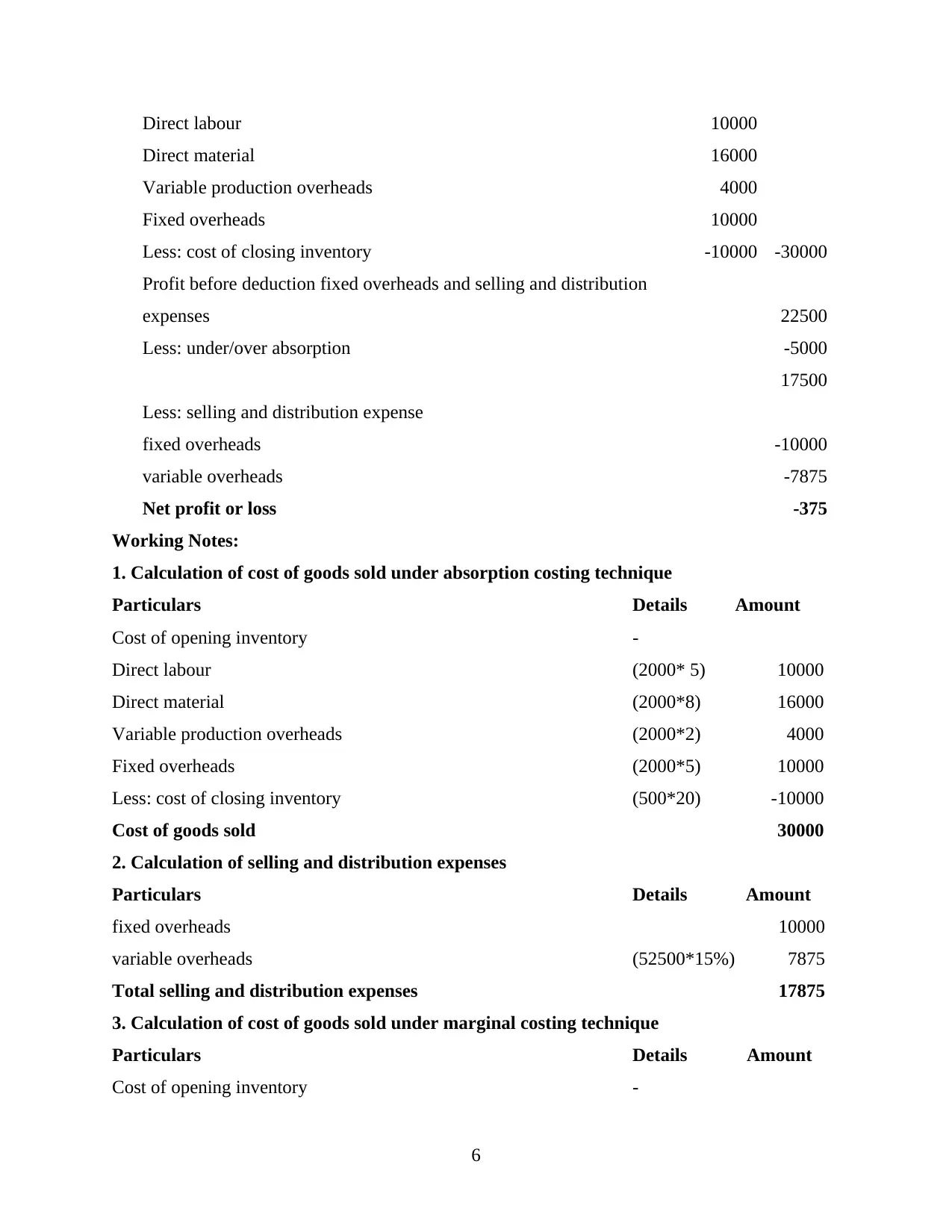
Direct labour 10000
Direct material 16000
Variable production overheads 4000
Fixed overheads 10000
Less: cost of closing inventory -10000 -30000
Profit before deduction fixed overheads and selling and distribution
expenses 22500
Less: under/over absorption -5000
17500
Less: selling and distribution expense
fixed overheads -10000
variable overheads -7875
Net profit or loss -375
Working Notes:
1. Calculation of cost of goods sold under absorption costing technique
Particulars Details Amount
Cost of opening inventory -
Direct labour (2000* 5) 10000
Direct material (2000*8) 16000
Variable production overheads (2000*2) 4000
Fixed overheads (2000*5) 10000
Less: cost of closing inventory (500*20) -10000
Cost of goods sold 30000
2. Calculation of selling and distribution expenses
Particulars Details Amount
fixed overheads 10000
variable overheads (52500*15%) 7875
Total selling and distribution expenses 17875
3. Calculation of cost of goods sold under marginal costing technique
Particulars Details Amount
Cost of opening inventory -
6
Direct material 16000
Variable production overheads 4000
Fixed overheads 10000
Less: cost of closing inventory -10000 -30000
Profit before deduction fixed overheads and selling and distribution
expenses 22500
Less: under/over absorption -5000
17500
Less: selling and distribution expense
fixed overheads -10000
variable overheads -7875
Net profit or loss -375
Working Notes:
1. Calculation of cost of goods sold under absorption costing technique
Particulars Details Amount
Cost of opening inventory -
Direct labour (2000* 5) 10000
Direct material (2000*8) 16000
Variable production overheads (2000*2) 4000
Fixed overheads (2000*5) 10000
Less: cost of closing inventory (500*20) -10000
Cost of goods sold 30000
2. Calculation of selling and distribution expenses
Particulars Details Amount
fixed overheads 10000
variable overheads (52500*15%) 7875
Total selling and distribution expenses 17875
3. Calculation of cost of goods sold under marginal costing technique
Particulars Details Amount
Cost of opening inventory -
6
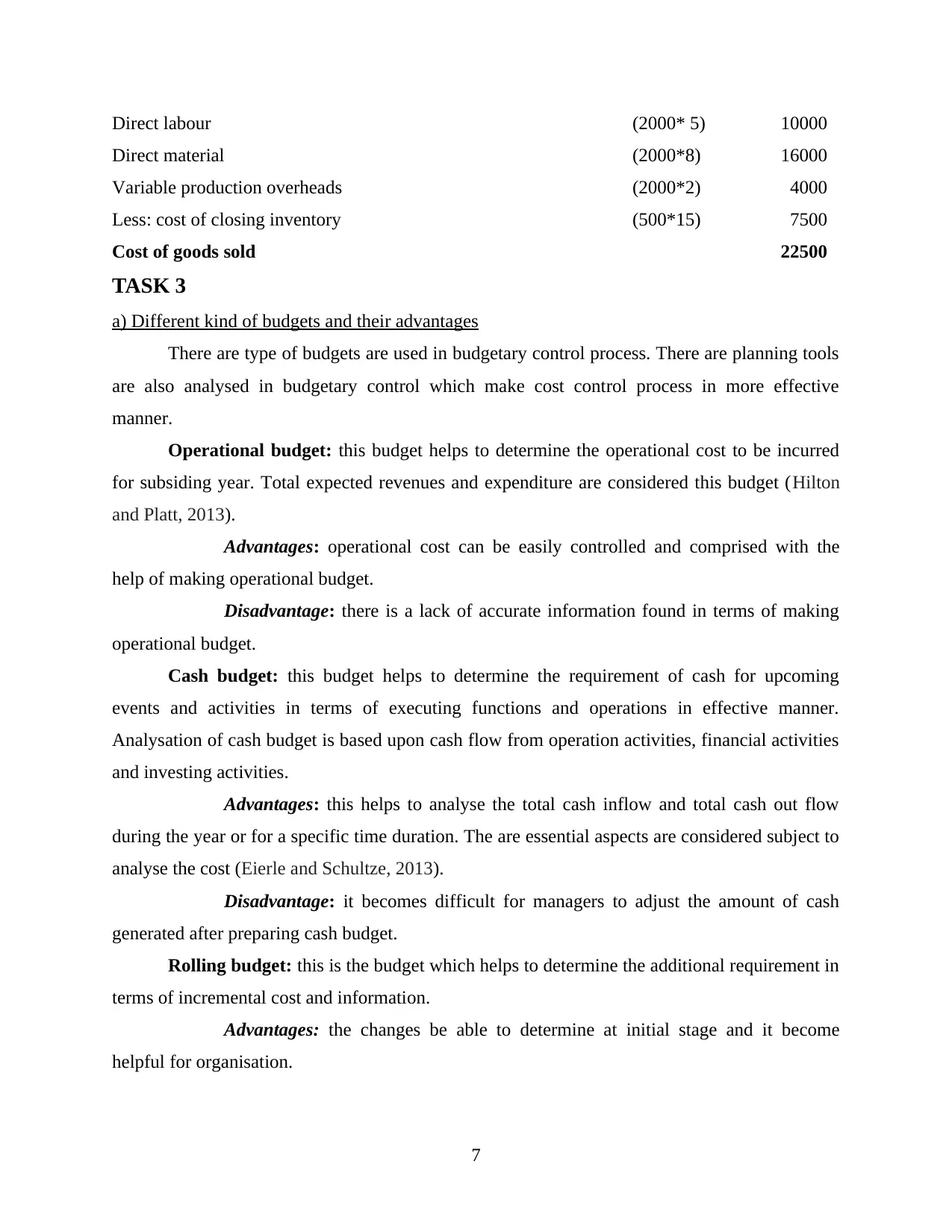
Direct labour (2000* 5) 10000
Direct material (2000*8) 16000
Variable production overheads (2000*2) 4000
Less: cost of closing inventory (500*15) 7500
Cost of goods sold 22500
TASK 3
a) Different kind of budgets and their advantages
There are type of budgets are used in budgetary control process. There are planning tools
are also analysed in budgetary control which make cost control process in more effective
manner.
Operational budget: this budget helps to determine the operational cost to be incurred
for subsiding year. Total expected revenues and expenditure are considered this budget (Hilton
and Platt, 2013).
Advantages: operational cost can be easily controlled and comprised with the
help of making operational budget.
Disadvantage: there is a lack of accurate information found in terms of making
operational budget.
Cash budget: this budget helps to determine the requirement of cash for upcoming
events and activities in terms of executing functions and operations in effective manner.
Analysation of cash budget is based upon cash flow from operation activities, financial activities
and investing activities.
Advantages: this helps to analyse the total cash inflow and total cash out flow
during the year or for a specific time duration. The are essential aspects are considered subject to
analyse the cost (Eierle and Schultze, 2013).
Disadvantage: it becomes difficult for managers to adjust the amount of cash
generated after preparing cash budget.
Rolling budget: this is the budget which helps to determine the additional requirement in
terms of incremental cost and information.
Advantages: the changes be able to determine at initial stage and it become
helpful for organisation.
7
Direct material (2000*8) 16000
Variable production overheads (2000*2) 4000
Less: cost of closing inventory (500*15) 7500
Cost of goods sold 22500
TASK 3
a) Different kind of budgets and their advantages
There are type of budgets are used in budgetary control process. There are planning tools
are also analysed in budgetary control which make cost control process in more effective
manner.
Operational budget: this budget helps to determine the operational cost to be incurred
for subsiding year. Total expected revenues and expenditure are considered this budget (Hilton
and Platt, 2013).
Advantages: operational cost can be easily controlled and comprised with the
help of making operational budget.
Disadvantage: there is a lack of accurate information found in terms of making
operational budget.
Cash budget: this budget helps to determine the requirement of cash for upcoming
events and activities in terms of executing functions and operations in effective manner.
Analysation of cash budget is based upon cash flow from operation activities, financial activities
and investing activities.
Advantages: this helps to analyse the total cash inflow and total cash out flow
during the year or for a specific time duration. The are essential aspects are considered subject to
analyse the cost (Eierle and Schultze, 2013).
Disadvantage: it becomes difficult for managers to adjust the amount of cash
generated after preparing cash budget.
Rolling budget: this is the budget which helps to determine the additional requirement in
terms of incremental cost and information.
Advantages: the changes be able to determine at initial stage and it become
helpful for organisation.
7
⊘ This is a preview!⊘
Do you want full access?
Subscribe today to unlock all pages.

Trusted by 1+ million students worldwide
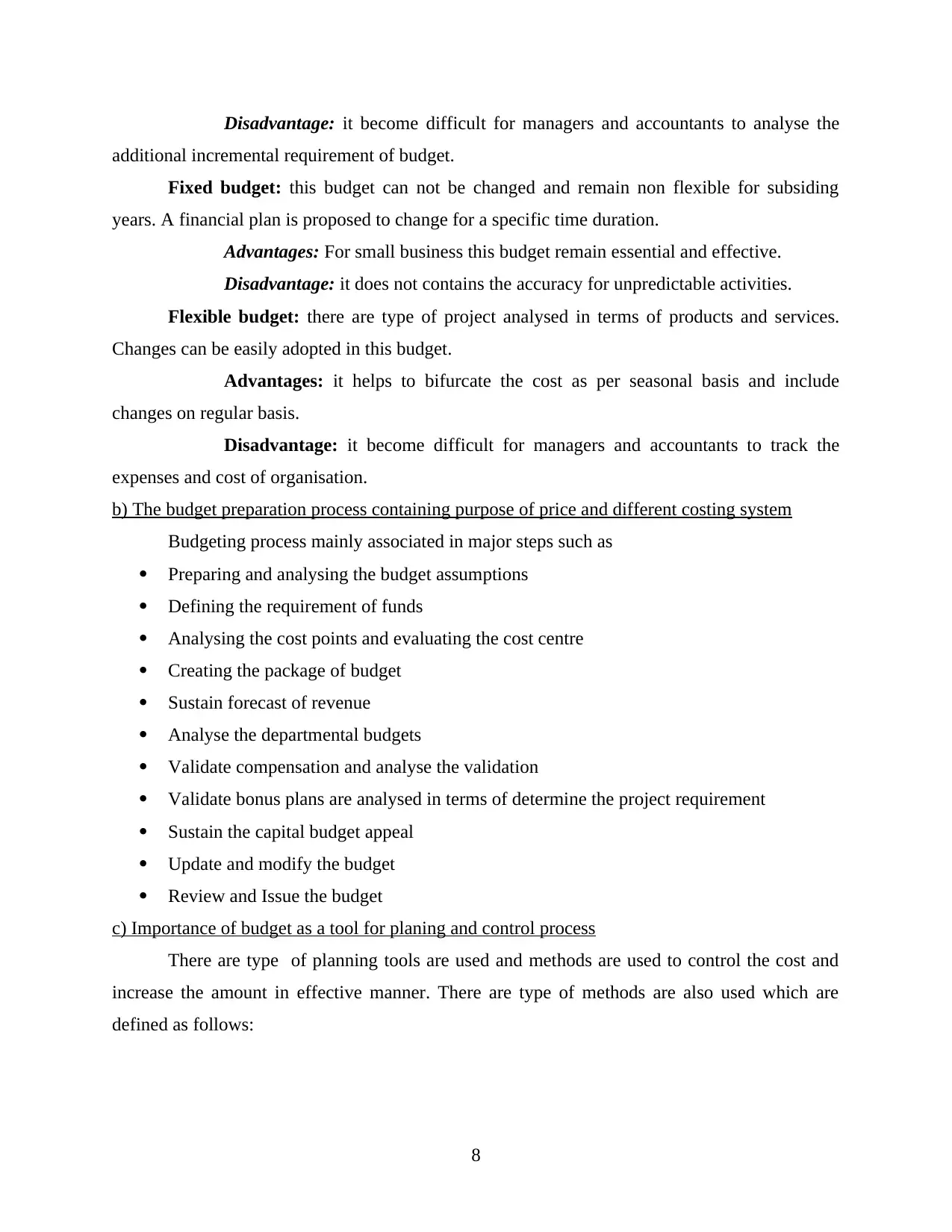
Disadvantage: it become difficult for managers and accountants to analyse the
additional incremental requirement of budget.
Fixed budget: this budget can not be changed and remain non flexible for subsiding
years. A financial plan is proposed to change for a specific time duration.
Advantages: For small business this budget remain essential and effective.
Disadvantage: it does not contains the accuracy for unpredictable activities.
Flexible budget: there are type of project analysed in terms of products and services.
Changes can be easily adopted in this budget.
Advantages: it helps to bifurcate the cost as per seasonal basis and include
changes on regular basis.
Disadvantage: it become difficult for managers and accountants to track the
expenses and cost of organisation.
b) The budget preparation process containing purpose of price and different costing system
Budgeting process mainly associated in major steps such as
Preparing and analysing the budget assumptions
Defining the requirement of funds
Analysing the cost points and evaluating the cost centre
Creating the package of budget
Sustain forecast of revenue
Analyse the departmental budgets
Validate compensation and analyse the validation
Validate bonus plans are analysed in terms of determine the project requirement
Sustain the capital budget appeal
Update and modify the budget
Review and Issue the budget
c) Importance of budget as a tool for planing and control process
There are type of planning tools are used and methods are used to control the cost and
increase the amount in effective manner. There are type of methods are also used which are
defined as follows:
8
additional incremental requirement of budget.
Fixed budget: this budget can not be changed and remain non flexible for subsiding
years. A financial plan is proposed to change for a specific time duration.
Advantages: For small business this budget remain essential and effective.
Disadvantage: it does not contains the accuracy for unpredictable activities.
Flexible budget: there are type of project analysed in terms of products and services.
Changes can be easily adopted in this budget.
Advantages: it helps to bifurcate the cost as per seasonal basis and include
changes on regular basis.
Disadvantage: it become difficult for managers and accountants to track the
expenses and cost of organisation.
b) The budget preparation process containing purpose of price and different costing system
Budgeting process mainly associated in major steps such as
Preparing and analysing the budget assumptions
Defining the requirement of funds
Analysing the cost points and evaluating the cost centre
Creating the package of budget
Sustain forecast of revenue
Analyse the departmental budgets
Validate compensation and analyse the validation
Validate bonus plans are analysed in terms of determine the project requirement
Sustain the capital budget appeal
Update and modify the budget
Review and Issue the budget
c) Importance of budget as a tool for planing and control process
There are type of planning tools are used and methods are used to control the cost and
increase the amount in effective manner. There are type of methods are also used which are
defined as follows:
8
Paraphrase This Document
Need a fresh take? Get an instant paraphrase of this document with our AI Paraphraser
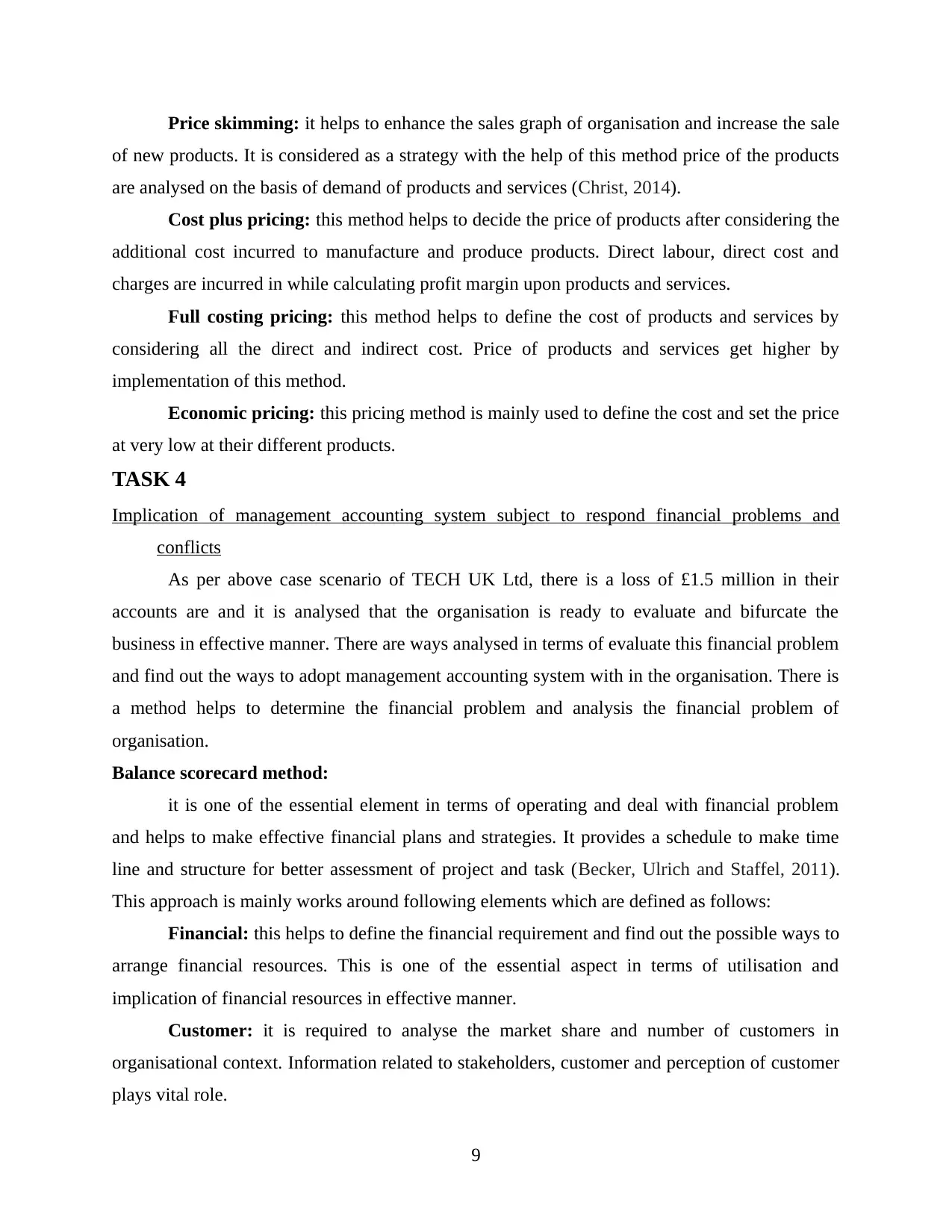
Price skimming: it helps to enhance the sales graph of organisation and increase the sale
of new products. It is considered as a strategy with the help of this method price of the products
are analysed on the basis of demand of products and services (Christ, 2014).
Cost plus pricing: this method helps to decide the price of products after considering the
additional cost incurred to manufacture and produce products. Direct labour, direct cost and
charges are incurred in while calculating profit margin upon products and services.
Full costing pricing: this method helps to define the cost of products and services by
considering all the direct and indirect cost. Price of products and services get higher by
implementation of this method.
Economic pricing: this pricing method is mainly used to define the cost and set the price
at very low at their different products.
TASK 4
Implication of management accounting system subject to respond financial problems and
conflicts
As per above case scenario of TECH UK Ltd, there is a loss of £1.5 million in their
accounts are and it is analysed that the organisation is ready to evaluate and bifurcate the
business in effective manner. There are ways analysed in terms of evaluate this financial problem
and find out the ways to adopt management accounting system with in the organisation. There is
a method helps to determine the financial problem and analysis the financial problem of
organisation.
Balance scorecard method:
it is one of the essential element in terms of operating and deal with financial problem
and helps to make effective financial plans and strategies. It provides a schedule to make time
line and structure for better assessment of project and task (Becker, Ulrich and Staffel, 2011).
This approach is mainly works around following elements which are defined as follows:
Financial: this helps to define the financial requirement and find out the possible ways to
arrange financial resources. This is one of the essential aspect in terms of utilisation and
implication of financial resources in effective manner.
Customer: it is required to analyse the market share and number of customers in
organisational context. Information related to stakeholders, customer and perception of customer
plays vital role.
9
of new products. It is considered as a strategy with the help of this method price of the products
are analysed on the basis of demand of products and services (Christ, 2014).
Cost plus pricing: this method helps to decide the price of products after considering the
additional cost incurred to manufacture and produce products. Direct labour, direct cost and
charges are incurred in while calculating profit margin upon products and services.
Full costing pricing: this method helps to define the cost of products and services by
considering all the direct and indirect cost. Price of products and services get higher by
implementation of this method.
Economic pricing: this pricing method is mainly used to define the cost and set the price
at very low at their different products.
TASK 4
Implication of management accounting system subject to respond financial problems and
conflicts
As per above case scenario of TECH UK Ltd, there is a loss of £1.5 million in their
accounts are and it is analysed that the organisation is ready to evaluate and bifurcate the
business in effective manner. There are ways analysed in terms of evaluate this financial problem
and find out the ways to adopt management accounting system with in the organisation. There is
a method helps to determine the financial problem and analysis the financial problem of
organisation.
Balance scorecard method:
it is one of the essential element in terms of operating and deal with financial problem
and helps to make effective financial plans and strategies. It provides a schedule to make time
line and structure for better assessment of project and task (Becker, Ulrich and Staffel, 2011).
This approach is mainly works around following elements which are defined as follows:
Financial: this helps to define the financial requirement and find out the possible ways to
arrange financial resources. This is one of the essential aspect in terms of utilisation and
implication of financial resources in effective manner.
Customer: it is required to analyse the market share and number of customers in
organisational context. Information related to stakeholders, customer and perception of customer
plays vital role.
9
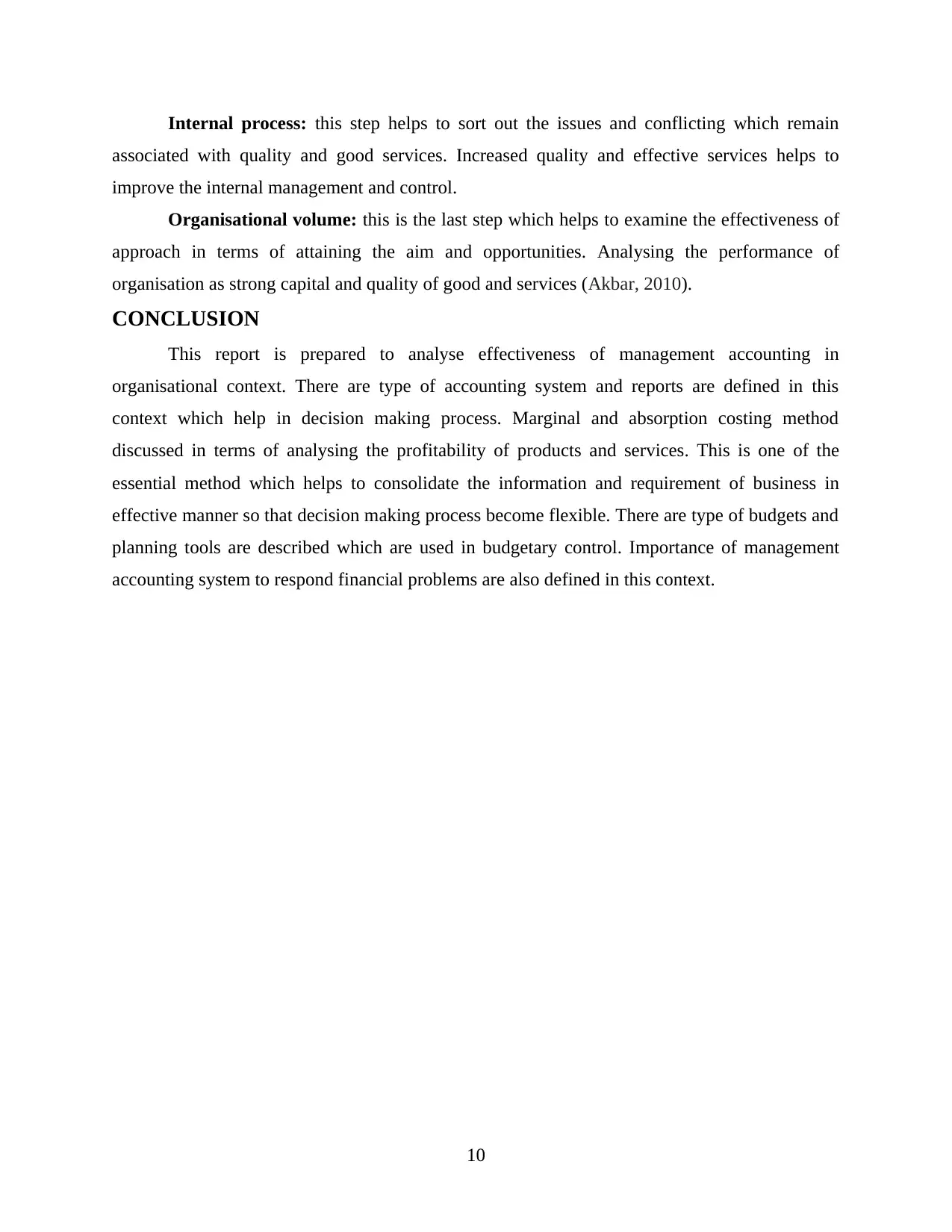
Internal process: this step helps to sort out the issues and conflicting which remain
associated with quality and good services. Increased quality and effective services helps to
improve the internal management and control.
Organisational volume: this is the last step which helps to examine the effectiveness of
approach in terms of attaining the aim and opportunities. Analysing the performance of
organisation as strong capital and quality of good and services (Akbar, 2010).
CONCLUSION
This report is prepared to analyse effectiveness of management accounting in
organisational context. There are type of accounting system and reports are defined in this
context which help in decision making process. Marginal and absorption costing method
discussed in terms of analysing the profitability of products and services. This is one of the
essential method which helps to consolidate the information and requirement of business in
effective manner so that decision making process become flexible. There are type of budgets and
planning tools are described which are used in budgetary control. Importance of management
accounting system to respond financial problems are also defined in this context.
10
associated with quality and good services. Increased quality and effective services helps to
improve the internal management and control.
Organisational volume: this is the last step which helps to examine the effectiveness of
approach in terms of attaining the aim and opportunities. Analysing the performance of
organisation as strong capital and quality of good and services (Akbar, 2010).
CONCLUSION
This report is prepared to analyse effectiveness of management accounting in
organisational context. There are type of accounting system and reports are defined in this
context which help in decision making process. Marginal and absorption costing method
discussed in terms of analysing the profitability of products and services. This is one of the
essential method which helps to consolidate the information and requirement of business in
effective manner so that decision making process become flexible. There are type of budgets and
planning tools are described which are used in budgetary control. Importance of management
accounting system to respond financial problems are also defined in this context.
10
⊘ This is a preview!⊘
Do you want full access?
Subscribe today to unlock all pages.

Trusted by 1+ million students worldwide
1 out of 12
Related Documents
Your All-in-One AI-Powered Toolkit for Academic Success.
+13062052269
info@desklib.com
Available 24*7 on WhatsApp / Email
![[object Object]](/_next/static/media/star-bottom.7253800d.svg)
Unlock your academic potential
Copyright © 2020–2025 A2Z Services. All Rights Reserved. Developed and managed by ZUCOL.





